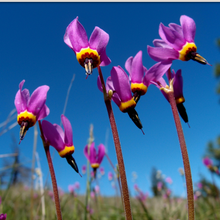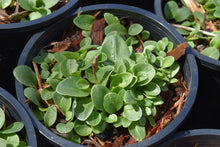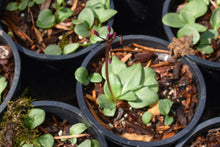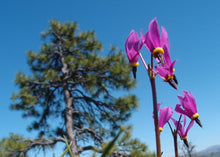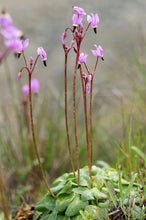
Dodecatheon hendersonii
This ephemeral spring beauty will take center stage in your garden each spring. It emerges as a small clump of fleshy, oval leaves followed by a slim, leafless stalk that becomes a pedestal for its exceptionally showy floral display. True to its name, the flowers are nodding clusters of recurved magenta petals that point to the sky like shooting stars, with black anthers hanging low. Like most spring bulbs, after its bloom, it dies back to the ground completely, until it steals your heart again next year.
- Plant type/canopy layer: deciduous, perennial, herbaceous plant
- Size at maturity: 0-12" tall, 0-8" wide
- Light requirements: full sun to part shade
- Moisture requirements: dry soil, seasonal wetness ok
- Bloom time: March - June
- Growth rate/ease: medium growth rate, easy to grow
- Wildlife support: flowers attract and support solitary bees and native bumble bees, the later of which can vibrate the flowers, aka “buzz-pollinate” while they are collecting pollen for their young; overall plant attracts and supports beneficial and other pest eating insects and is a caterpillar host plant and larval food source for native butterflies and moths
- Native habitat/range: locally common in meadows, grasslands, oak and conifer woodland openings and edges and vernal wet areas west of the Cascades, at low to mid-elevations up to 2000m, in northern California, Oregon, Washington, and southern Vancouver Island. Portland Plant List - yes.
What to Expect + Gardening with Broad-leaved Shooting Star: For spring orders, depending on the weather and the date of your order pick-up, bulbs may be just emerging or already dying back for the season. Bulbs can be fragile when they're actively growing in spring. So, either plant with care or keep it in its pot and wait until it dies back before planting. By early summer, the plant will die back completely and the bulb will be easy to transplant. If you go this route, leave the pot in a sheltered place and water sparingly, so that you don't rot the bulb.
For fall orders, you can expect what looks like a pot of dirt. The bulb inside may appear slightly shriveled, which is its normal, dormant fall look. Fall is an excellent time to plant bulbs.
Once planted, it should grow easily provided it's in the right place. It prefers well-drained soil and part sun/part shade but is tolerant of full sun. A true Oregonian, it tolerates seasonally wet soils but wants to dry out in the summertime, making it a good fit for a partially sunny raingarden, pollinator garden, rock garden, or meadowscape. Do note, it's relatively small and ephemeral, only peaking out to explode into its oh-so-striking glory for a blip before hiding underground until next year. So, be sure to place this front and center, where you’ll enjoy every moment of its spectacular bloom. Slugs have a special radar for seeking out the succulent leaves of this beauty. So placing it in clear sight will help you know when to embark on head-lamp clad nighttime slug hunts, pull out the beer traps, or eventually resort to an OMRI certified iron phosphate product.
Photo Credits 1 -4: Nikkie West, Sparrowhawk Native Plants
Photo Credit 5: "Primula (Dodecatheon) hendersonii" by John Game is licensed under CC BY 2.0





